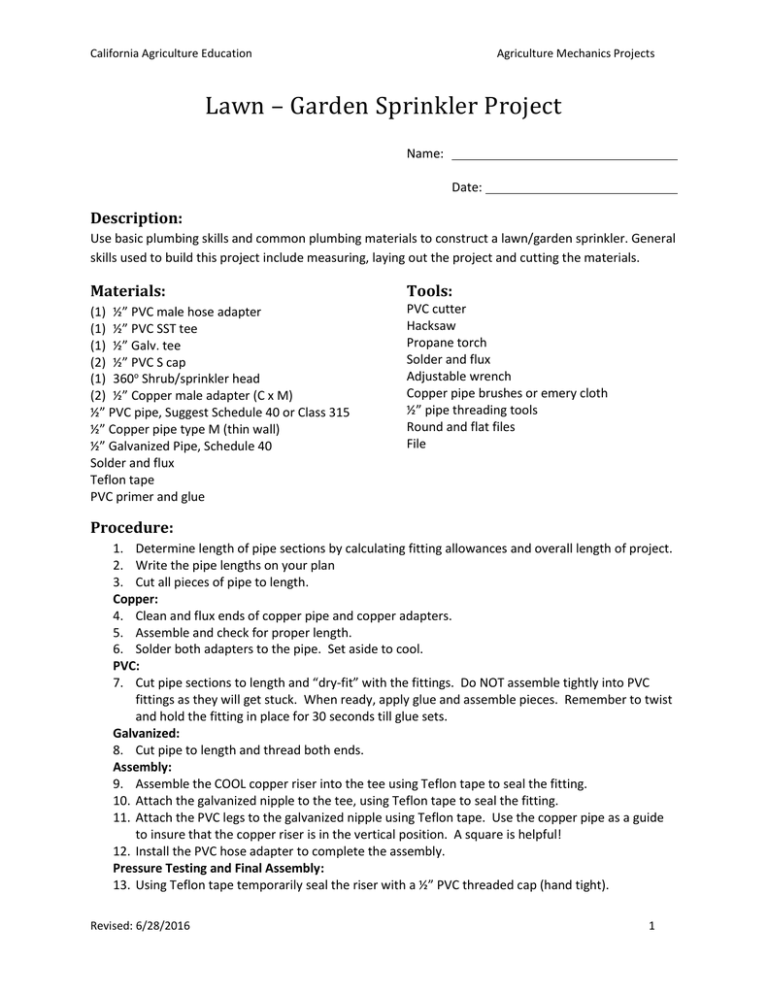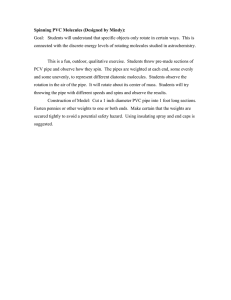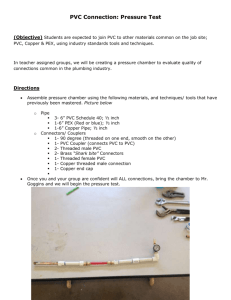Lawn – Garden Sprinkler Project Description:
advertisement

California Agriculture Education Agriculture Mechanics Projects Lawn – Garden Sprinkler Project Name: Date: Description: Use basic plumbing skills and common plumbing materials to construct a lawn/garden sprinkler. General skills used to build this project include measuring, laying out the project and cutting the materials. Materials: Tools: (1) ½” PVC male hose adapter (1) ½” PVC SST tee (1) ½” Galv. tee (2) ½” PVC S cap (1) 360o Shrub/sprinkler head (2) ½” Copper male adapter (C x M) ½” PVC pipe, Suggest Schedule 40 or Class 315 ½” Copper pipe type M (thin wall) ½” Galvanized Pipe, Schedule 40 Solder and flux Teflon tape PVC primer and glue PVC cutter Hacksaw Propane torch Solder and flux Adjustable wrench Copper pipe brushes or emery cloth ½” pipe threading tools Round and flat files File Procedure: 1. Determine length of pipe sections by calculating fitting allowances and overall length of project. 2. Write the pipe lengths on your plan 3. Cut all pieces of pipe to length. Copper: 4. Clean and flux ends of copper pipe and copper adapters. 5. Assemble and check for proper length. 6. Solder both adapters to the pipe. Set aside to cool. PVC: 7. Cut pipe sections to length and “dry-fit” with the fittings. Do NOT assemble tightly into PVC fittings as they will get stuck. When ready, apply glue and assemble pieces. Remember to twist and hold the fitting in place for 30 seconds till glue sets. Galvanized: 8. Cut pipe to length and thread both ends. Assembly: 9. Assemble the COOL copper riser into the tee using Teflon tape to seal the fitting. 10. Attach the galvanized nipple to the tee, using Teflon tape to seal the fitting. 11. Attach the PVC legs to the galvanized nipple using Teflon tape. Use the copper pipe as a guide to insure that the copper riser is in the vertical position. A square is helpful! 12. Install the PVC hose adapter to complete the assembly. Pressure Testing and Final Assembly: 13. Using Teflon tape temporarily seal the riser with a ½” PVC threaded cap (hand tight). Revised: 6/28/2016 1 California Agriculture Education Agriculture Mechanics Projects 14. Pressure test the assembly. If there are no leaks, remove the cap and install the sprinkler head. 15. Label the project with your name and turn in for final grading. Photo/Drawing: Revised: 6/28/2016 2 California Agriculture Education Revised: 6/28/2016 Agriculture Mechanics Projects 3 California Agriculture Education Agriculture Mechanics Projects Sprinkler Project Worksheet Name: _________________ Date: _________________ 1. How do you calculate the length of the pieces of pipe? 2. What are the actual lengths of the PVC pipe pieces? ________________ 3. What is the length of the copper pipe? ______________ 4. Name the two ways to cut PVC pipe. 5. What are the steps in soldering copper pipe? 6. Why is important to wrap pipe threads in Teflon tape? Grading Rubric: CRITERIA POSSIBLE Accuracy of dimensions 5 Quality of threads on Galv. Pipe 5 Assembly (project is flat and angle of riser is 90°) 5 Workmanship (no excess primer, cement, or solder) 5 Fitting Test (no leaks) 10 TOTAL 30 Revised: 6/28/2016 SCORE 4 California Agriculture Education Agriculture Mechanics Projects Sprinkler Project Teacher’s Notes: Pressure testing of the project can be done with an air supply and a bucket. Make a tester with a pressure regulator, a ball valve, and a ¾” male hose adapter. The tester is attached to the project at the hose fitting and the project is dunked in the bucket. Bubbles are bad….. A water hose can also be small leaks are harder to see. Agricultural Standards Met: 6.0 Health and Safety. Students understand health and safety policies, procedures, regulations, and practices, including the use of equipment and handling of hazardous materials: 6.1 Know policies, procedures, and regulations regarding health and safety in the workplace, including employers’ and employees’ responsibilities. 6.2 Understand critical elements of health and safety practices related to storing, cleaning, and maintaining tools, equipment, and supplies. 6.4 Maintain safe and healthful working conditions. 6.5 Use tools and machines safely and appropriately. 6.6 Know how to both prevent and respond to accidents in the agricultural industry. B1.0 Students understand personal and group safety: B1.1 Practice the rules for personal and group safety while working in an agricultural mechanics environment. B1.2 Know the relationship between accepted shop management procedures and a safe working environment. B4.0 Students understand plumbing system practices commonly used in agriculture: B4.1 Know basic plumbing fitting skills with a variety of materials, such as copper, PVC (polyvinyl chloride), steel, polyethylene, and ABS (acrylonitrile butadiene styrene). B4.2 Understand the environmental influences on plumbing system choices (e.g., filter systems, water disposal). B4.3 Know how various plumbing and irrigation systems are used in agriculture. B4.4 Complete a plumbing project, including interpreting a plan, developing a bill of materials and cutting list, selecting materials, joining, and testing. Objectives: By properly completing this project, students will be able to: Read a plan and determine layout dimensions. Demonstrate proper PVC, Galvanized, and Copper plumbing techniques. Alternative Tools/Methods/Materials: Riser: substitute 5" PVC nipple. Riser: Make a galvanized nipple. Safety Review: Basic shop safety PVC primer/glue fumes Torch use Threading Revised: 6/28/2016 5 California Agriculture Education Agriculture Mechanics Projects Project Time: Demonstration: 30 minutes Build: 2 hours Demonstration Notes 1. To find overall length of a section, measure length of the fitting and use standard pipe allowance (~ ½“) to determine how long to cut each piece of pipe. Pieces will be shorter than overall length of the section. 2. Primer is not normally used on pipe under 1” in diameter. However you can apply on the project to demonstrate its use. 3. Do not dry fit PVC fittings. Fittings are tapered and will bind. If you want to demonstrate a “dry fit” you can cut a slot in the ends of the pipe, but this is not acceptable for an actual project as it will weaken the joint. 4. When cementing PVC pieces, give the parts a half turn when joining, then hold in place for several seconds until it sets. This will insure the cement lines the entire fitting and that pipe does not back out of fitting. 5. Remember the 3 Cs of good soldering: clean, clean, clean. 6. Use the torch on the opposite side of where solder will be applied – the heat will draw the solder into the joint. You need very little solder (1/4”) Bill of Materials: Projects: 24 Size Description Units 1/2" Copper pipe 20' length 1/2" Copper fitting CxM each 1/2" PVC pipe 20' length 1/2" PVC cap 1/2" Qty/Project Cost/Unit Order Amount 0.025 $37.87 1 $ 37.87 2 $1.44 20 $ 28.80 0.05 $3.81 2 $ 7.62 each 2 $0.24 48 $ 11.52 PVC tee, SST each 1 $0.44 24 $ 10.56 1/2" Galv. Schedule 40 Pipe 21' length 0.04 $22.00 1 $ 22.00 1/2" Galv. Tee each 0 $1.50 1 $ 1.50 1/2" PVC hose adapter each 1 $1.83 24 $ 43.92 1/2" Sprinkler head each 1 $1.48 24 $ 35.52 TOTAL $ 177.31 Project from: 2013 CATA Skills Session Participants, Dick Piersma, and Mike Spiess. Revised: 6/28/2016 6

